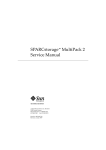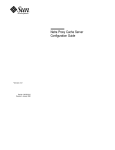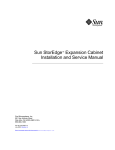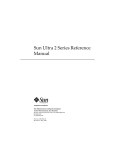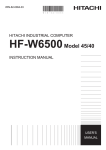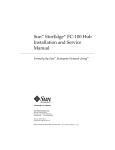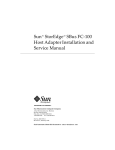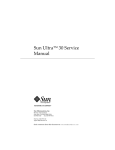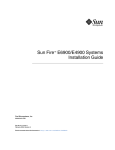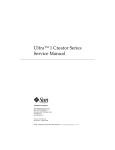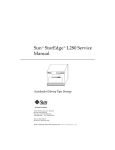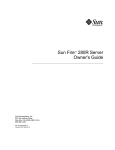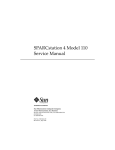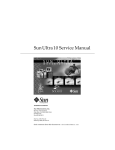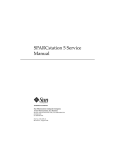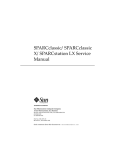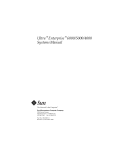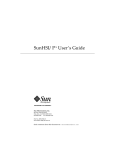Download Netra 150 Server Hardware Installation Manual
Transcript
Netra 150 Server Hardware Installation Manual A Sun Microsystems, Inc. Business 901 San Antonio Road Palo Alto, , CA 94303-4900 Part No: 802-7555-10 Revision A, February 1997 USA 650 960-1300 fax 650 969-9131 Netra 150 Server Hardware Installation Manual Part No: 802-7555-10 Revision A, February 1997 Copyright 1997 Sun Microsystems, Inc. 901 San Antonio Road, Palo Alto, California 94303-4900 U.S.A. All rights reserved. All rights reserved. This product or document is protected by copyright and distributed under licenses restricting its use, copying, distribution, and decompilation. No part of this product or document may be reproduced in any form by any means without prior written authorization of Sun and its licensors, if any. Portions of this product may be derived from the UNIX® system, licensed from Novell, Inc., and from the Berkeley 4.3 BSD system, licensed from the University of California. UNIX is a registered trademark in the United States and in other countries and is exclusively licensed by X/Open Company Ltd. Third-party software, including font technology in this product, is protected by copyright and licensed from Sun’s suppliers. RESTRICTED RIGHTS: Use, duplication, or disclosure by the U.S. Government is subject to restrictions of FAR 52.227-14(g)(2)(6/87) and FAR 52.227-19(6/87), or DFAR 252.227-7015(b)(6/95) and DFAR 227.7202-3(a). Sun, Sun Microsystems, the Sun logo, and Solaris are trademarks or registered trademarks of Sun Microsystems, Inc. in the United States and in other countries. All SPARC trademarks are used under license and are trademarks or registered trademarks of SPARC International, Inc. in the United States and in other countries. Products bearing SPARC trademarks are based upon an architecture developed by Sun Microsystems, Inc. TM The OPEN LOOK® and Sun Graphical User Interfaces were developed by Sun Microsystems, Inc. for its users and licensees. Sun acknowledges the pioneering efforts of Xerox Corporation in researching and developing the concept of visual or graphical user interfaces for the computer industry. Sun holds a nonexclusive license from Xerox to the Xerox Graphical User Interface, which license also covers Sun’s licensees who implement OPEN LOOK GUIs and otherwise comply with Sun’s written license agreements. THIS PUBLICATION IS PROVIDED “AS IS” WITHOUT WARRANTY OF ANY KIND, EITHER EXPRESS OR IMPLIED, INCLUDING, BUT NOT LIMITED TO, THE IMPLIED WARRANTIES OF MERCHANTABILITY, FITNESS FOR A PARTICULAR PURPOSE, OR NON-INFRINGEMENT. Copyright 1997 Sun Microsystems, Inc., 901 San Antonio Road, Palo Alto, Californie 94303-4900 U.S.A. Tous droits réservés. Ce produit ou document est protégé par un copyright et distribué avec des licences qui en restreignent l’utilisation, la copie et la décompilation. Aucune partie de ce produit ou de sa documentation associée ne peut être reproduite sous aucune forme, par quelque moyen que ce soit, sans l’autorisation préalable et écrite de Sun et de ses bailleurs de licence, s’il y en a. Des parties de ce produit pourront être derivées du système UNIX® licencié par Novell, Inc. et du système Berkeley 4.3 BSD licencié par l’Université de Californie. UNIX est une marque enregistrée aux Etats-Unis et dans d’autres pays, et licenciée exclusivement par X/Open Company Ltd. Le logiciel détenu par des tiers, et qui comprend la technologie relative aux polices de caractères, est protégé par un copyright et licencié par des fournisseurs de Sun. Sun, Sun Microsystems, le logo Sun, et Solaris sont des marques déposées ou enregistrées de Sun Microsystems, Inc. aux Etats-Unis et dans d’autres pays. Toutes les marques SPARC, utilisées sous licence, sont des marques déposées ou enregistrées de SPARC International, Inc. aux Etats-Unis et dans d’autres pays. Les produits portant les marques SPARC sont basés sur une architecture développée par Sun Microsystems, Inc. TM Les utilisateurs d’interfaces graphiques OPEN LOOK® et Sun ont été développés de Sun Microsystems, Inc. pour ses utilisateurs et licenciés. Sun reconnaît les efforts de pionniers de Xerox Corporation pour la recherche et le développement du concept des interfaces d’utilisation visuelle ou graphique pour l’industrie de l’informatique. Sun détient une licence non exclusive de Xerox sur l’interface d’utilisation graphique, cette licence couvrant aussi les licenciés de Sun qui mettent en place les utilisateurs d’interfaces graphiques OPEN LOOK et qui en outre se conforment aux licences écrites de Sun. CETTE PUBLICATION EST FOURNIE "EN L’ETAT" SANS GARANTIE D’AUCUNE SORTE, NI EXPRESSE NI IMPLICITE, Y COMPRIS, ET SANS QUE CETTE LISTE NE SOIT LIMITATIVE, DES GARANTIES CONCERNANT LA VALEUR MARCHANDE, L’APTITUDE DES PRODUITS A REPONDRE A UNE UTILISATION PARTICULIERE OU LE FAIT QU’ILS NE SOIENT PAS CONTREFAISANTS DE PRODUITS DE TIERS. Please Recycle Contents Preface 1. x Installing the Netra 150 Server Netra 150 Server Inventory 1 1 Installing the Netra 150 Server 2 Connecting the Server to the Network 2 Connecting an External Peripheral 4 Connecting a Monitor and Keyboard 6 Connecting a TTY Terminal 7 Performing the Initial Configuration 8 Using a PC for Initial Configuration H H H H To Prepare for Configuration 9 10 To Create a Partial Configuration Diskette 10 To Complete the Initial Configuration 13 To Complete Other Configuration Tasks 15 Using a Monitor for Initial Configuration 15 H H H H To Prepare for Configuration 15 To Log In to the Netra Server 16 To Perform the Initial Configuration 17 To Complete the Configuration 18 Contents iv Using TTY for the Initial Configuration H H H H To Prepare for Configuration 20 20 To Run the Setup Script 21 To Complete the Initial Configuration from a Client PC 23 To Complete Other Configuration Tasks 25 Using the LCD Panel for Initial Configuration 26 H H H H To Prepare for Configuration 26 To Perform the Initial Configuration Using the LCD Display To Complete the Initial Configuration 31 To Complete the Configuration 32 Powering Off the System 34 2. Adding or Replacing Hardware in the Netra 150 Server 37 Safety Requirements System Precautions Tools Required 37 38 39 Electrostatic Discharge (ESD) Precautions 39 Powering Off the Netra 150 Server 40 Opening or Removing the Panels 41 Opening the Upper Front Panel 42 Opening the Lower Front Panel 43 Removing the Left Panels and Foam Piece 1 43 Attaching the Antistatic Wrist Strap Installing or Replacing Hardware 48 49 Installing or Replacing the Tape Drive 49 Installing or Replacing Bay Disk Drives 52 Installing or Replacing SBus Cards 55 Installing or Replacing DSIMMs 62 Finishing Up v 65 Netra 150 Server Hardware Installation Manual ♦ Revision A, February 1997 26 Closing and Installing Panels 65 Powering On the System 69 A. System Specifications 71 Physical Specifications 71 Electrical Specifications 72 Environmental Requirements 73 B. Understanding Battery Management Issues for a Netra 150 Server (NFS Version Only) 75 Battery Management for the Netra NFS Server 75 UPS Vendors 77 H To Connect the Backup Power System to an External Disk Enclosure 77 C. Safety Agency Compliance Statements 83 Safety Agency Compliance Statements 83 Safety Precautions 83 Symbols 83 Modifications to Equipment 84 Placement of a Sun Product 84 SELV Compliance 85 Power Cord Connection 85 Lithium Battery 85 System Unit Cover 86 CD-ROM 86 Einhaltung sicherheitsbehördlicher Vorschriften 86 Sicherheitsvorkehrungen 86 Symbole 87 Aufstellung von Sun-Geräten 88 Einhaltung der SELV-Richtlinien 88 Anschluß des Netzkabels 88 Contents vi Lithiumbatterie 89 Gehäuseabdeckung 89 CD-ROM 90 Conformité aux normes de sécurité 90 Mesures de sécurité 90 Symboles 90 Modification du matériel 91 Positionnement d’un produit Sun Conformité SELV 91 92 Connexion du cordon d’alimentation 92 Batterie au lithium 93 Couvercle 93 CD-ROM 93 Normativas de seguridad 94 Precauciones de seguridad 94 Símbolos 94 Modificaciones en el equipo 95 Ubicación de un producto Sun 95 Cumplimiento de la normativa SELV 96 Conexión del cable de alimentación eléctrica 96 Batería de litio 97 Tapa de la unidad del sistema 97 CD-ROM 97 Nordic Lithium Battery Cautions 97 Norge 97 Sverige 98 Danmark 98 Suomi 98 vii Netra 150 Server Hardware Installation Manual ♦ Revision A, February 1997 D. Regulatory Compliance Statements 99 FCC Class A Notice 99 FCC Class B Notice 100 DOC Class A Notice - Avis DOC, Classe A 101 DOC Class B Notice - Avis DOC, Classe B 101 Declaration of Conformity EMC 102 102 Safety 103 Supplementary Information 103 Index 105 Contents viii ix Netra 150 Server Hardware Installation Manual ♦ Revision A, February 1997 Preface This manual is written for an experienced end-user. How This Book Is Organized This manual is divided into the following chapters: Chapter 1” gives information on connecting the Netra 150 server to the network and going through the initial configuration. Chapter 2” gives instructions on adding hardware to a Netra 150 server. Appendix A” gives the system specifications for the Netra 150 server. Appendix B” gives the information on battery management issues for the NFS version of the Netra 150 server. Ordering Sun Documents The SunDocs Order Desk is a distribution center for Sun Microsystems technical documentation. You can use major credit cards and company purchase orders. You can order documentation in the following ways: Preface x TABLE P–1 Sun Documents Information Fax 1-800-944-0661 Call 1-800-873-7869 World Wide Web: http://www.sun.com/sunexpress/ Typographic Conventions The following table describes the typographic changes used in this book. TABLE P–2 Typographic Conventions Typeface or Symbol AaBbCc123 Meaning Example The names of commands, files, and directories; on-screen computer output Edit your .login file. Use ls -a to list all files. machine_name% You have mail. AaBbCc123 What you type, contrasted with on-screen computer output machine_name% suPassword: AaBbCc123 Command-line placeholder: To delete a file, type rm filename. replace with a real name or value AaBbCc123 Book titles, new words or terms, or words to be emphasized Read Chapter 6 in the User’s Guide. These are called class options. You must be root to do this. Shell Prompts in Command Examples The following table shows the default system prompt and superuser prompt for the C shell, Bourne shell, and Korn shell. xi Netra 150 Server Hardware Installation Manual ♦ Revision A, February 1997 TABLE P–3 Shell Prompts Shell Prompt C shell machine_name% C shell superuser machine_name# Bourne shell and Korn shell $ Bourne shell and Korn shell superuser # xii xiii Netra 150 Server Hardware Installation Manual ♦ Revision A, February 1997 CHAPTER 1 Installing the Netra 150 Server This chapter describes how to install your Netra 150 server. Netra 150 Server Inventory You should have received the following items with your Netra 150 server: 4 Sun Microsystems Netra 150 server 4 Power cord 4 Twisted-pair Ethernet (RJ-45) cable 4 Configuration Utilities diskette 4 Netra server: Recovery CD 4 Netra 150 Server Hardware Installation Manual 4 Netra 150 Server Service Manual 4 Netra 150 Server Storage Device User’s Guide 4 Netra User’s Manual Figure 1–1 shows the standard inventory for a Netra 150 server. 1 Figure 1–1 Standard Inventory for the Netra 150 Server Caution - The Netra Server: Recovery CD and the Netra configuration diskette are separate items and do not contain the same types of information. The CD is intended only for limited uses (including emergencies, such as system software recovery). The unintentional use of the CD may cause destruction of email files and other data. Installing the Netra 150 Server Note - If you want to install an internal peripheral, DSIMM or SBus card into your Netra 150 server, do so now. Refer to Chapter 2” for those instructions. Connecting the Server to the Network 1. If you have the rack-ready version of the Netra 150 server, install it in the rack if you haven’t already done so. Refer to the Model 150 Series Rack-Ready Installation Manual for those instructions. 2. Verify that the Netra 150 server power switch is in the OFF (O) position (Figure 1–2). 2 Netra 150 Server Hardware Installation Manual ♦ Revision A, February 1997 Figure 1–2 Connecting the Netra 150 Server to the Network 3. Connect the power cord to the AC power receptacle at the rear of the Netra 150 server (Figure 1–2). 4. Connect a network cable from the Internet connection to one of the two Ethernet ports at the rear of the Netra 150 server (Figure 1–2). 5. Verify that an external fast wide SCSI cable is connected between the appropriate SCSI ports as shown in Figure 1–3. Installing the Netra 150 Server 3 Figure 1–3 Connecting the SCSI Cable 6. Determine if you have any other connections to make. 4 If you want to connect an external peripheral to your Netra 150 server, go to “Connecting an External Peripheral” on page 4. 4 If you want to connect a monitor and keyboard to your Netra 150 server, go to “Connecting a Monitor and Keyboard” on page 6. 4 If you want to connect a TTY terminal to your Netra 150 server, go to “Connecting a TTY Terminal” on page 7. 4 If you have no other connections to make, go to “Performing the Initial Configuration” on page 8. Connecting an External Peripheral Note - If you are connecting an external disk enclosure to the Netra NFS version of the Netra 150 server, read Appendix B” before proceeding with these instructions. 1. Determine if you are connecting an external peripheral to the Netra Internet or Netra NFS version of the Netra 150 server. 4 Netra 150 Server Hardware Installation Manual ♦ Revision A, February 1997 4 If you are connecting an external peripheral to the Netra Internet version of the Netra 150 server, connect the SCSI cable from the external peripheral to the on-board SCSI port at the rear of the Netra 150 server (Figure 1–4). Note that the internal floppy, tape and CD-ROM drives take SCSI addresses 0, 4 and 6, respectively, so you must verify that none of the drives in the external peripheral use those SCSI addresses. 4 If you are connecting an external tape enclosure to the Netra NFS version of the Netra 150 server, connect the SCSI cable from the external tape enclosure to the on-board SCSI port at the rear of the Netra 150 server (Figure 1–4). 4 If you are connecting an external disk enclosure to the Netra NFS version of the Netra 150 server, connect the SCSI cable from the external disk enclosure to the Fast-Wide SCSI card installed in SBus slot 1 at the rear of the Netra 150 server (Figure 1–4). If you do not have a Fast-Wide SCSI card installed in SBus slot 1, follow the instructions in “Installing an SBus Card” on page 55 to install a Fast-Wide SCSI card in SBus slot 1, then return here. Do not connect the external disk enclosure to any SCSI port other than the Fast-Wide SCSI card installed in SBus slot 1. Figure 1–4 Connecting External Peripherals to the Netra 150 Server 2. Power on the peripheral. Installing the Netra 150 Server 5 Refer to the manual that you received with your external peripheral for those instructions. Note - If you are connecting an external tape drive to your Netra 150 server (such as the SPARCstorage Library) and you want to use the new external tape drive to back up the data on your system, you must make the necessary software changes to make the new tape drive available for backup. Refer to the software manual that came with your system for those instructions. If you have no other connections to make, go to “Performing the Initial Configuration” on page 8. Connecting a Monitor and Keyboard 1. Verify that a frame buffer has been installed in one of the available SBus slots in the Netra 150 server (Figure 1–5). If you do not have a frame buffer already installed in the Netra 150 server, follow the instructions in “Installing or Replacing SBus Cards” on page 55 to install one. Figure 1–5 6 Connecting a Monitor and Keyboard to the Netra 150 Server Netra 150 Server Hardware Installation Manual ♦ Revision A, February 1997 2. Connect the monitor cable to the monitor port on the frame buffer installed in the SBus slot in the Netra 150 server. 3. Connect the keyboard to the keyboard port at the rear of the Netra 150 server (Figure 1–5). 4. Power on the monitor. Refer to the manual that you received with the monitor for those instructions. If you have no other connections to make, go to “Performing the Initial Configuration” on page 8. Connecting a TTY Terminal 1. Connect the terminal cable to serial port A (Figure 1–6). Do not connect the terminal cable to serial port B. Figure 1–6 Connecting a TTY Terminal to the Netra 150 Server Installing the Netra 150 Server 7 2. Power on the TTY terminal. Refer to the manual that you received with the TTY terminal for those instructions. If you have no other connections to make, go to “Performing the Initial Configuration” on page 8.” Performing the Initial Configuration After you have made the necessary hardware connections for the Netra 150 server, you must configure it with information that is specific to your site. You have several choices when performing the initial configuration. See the flowchart in Figure 1–7 for an overview of the configuration process. 8 Netra 150 Server Hardware Installation Manual ♦ Revision A, February 1997 Figure 1–7 Flow Chart for Initial Configuration Using a PC for Initial Configuration When you use a PC on the LAN for the initial configuration, you will perform the following general tasks: 4 Create a partial configuration diskette using the Utilities diskette that was shipped with your Netra system. 4 Connect the Netra server to the LAN, insert the partial configuration diskette, and power on the Netra server. Installing the Netra 150 Server 9 4 Use a client on the LAN to complete the initial configuration. The process is described in detail in the following sections. To Prepare for Configuration 1. Obtain configuration information for your site: 4 Host name for your Netra server 4 Type of network interface card, Ethernet port, and network protocol 4 LAN interface information (host address and netmask for a TCP/IP network, or network number and frame type for an SPX/IPX network [Netra Internet 150 server only]) 4 System administrator alias members 4 Root password 4 Administration Web Server password 4 Date and Time Refer to the Netra User’s Manual if you need help obtaining this information. To Create a Partial Configuration Diskette 1. Insert the Configuration Utilities diskette into the PC diskette drive. 2. Access drive A: c:\ a: 3. Run the following program: a:\ config The following is displayed: This program generates a configuration file for the local area network interface. Values shown in square brackets are the default values. 4. Enter the name of the Netra server. Enter the Host Name for the Netra Server: 10 Netra 150 Server Hardware Installation Manual ♦ Revision A, February 1997 5. Enter the number that corresponds to the network interface in your server: The following interfaces may be available on your Netra server: 1) Lance Ethernet 2) Quad Ethernet 3) Fast Ethernet 4) Token Ring 5) Fast Ethernet 100baseT 6) FDDI Enter the number corresponding to the interface to be configured [1]: 6. Enter the Ethernet port that you are using to connect the Netra server to the LAN: Which port are you using on the Netra to connect to the local area network? [0]: 7. Enter the number corresponding to the type of network you have: The following types of networks are available: 1) TCP/IP 2) Novell (SPX/IPX) Enter the number corresponding to the network type [1]: Note - SPX/IPX is not supported for Netra NFS, so if you have a Netra NFS 150 server, enter 1 (TCP/IP) for this question. 8. Now enter information for your network type as follows. 4 If you typed 1 for a TCP/IP network: 1. Enter the Netra server’s local area network host address: Enter the local area network host address for the Netra server: 2. Enter the netmask: Enter the local area network netmask for the Netra server [255.255.255.0]: The information you enter is saved on the diskette. This diskette now contains partial configuration information for your Netra server. 3. Go to Step 9 on page 12. 4 If you typed 2, for a Novell (SPX/IPX) network: 1. Enter the IPX network number (refer to the software manual that you received with your system for more information on SPX/IPX network numbers and frame types): Installing the Netra 150 Server 11 Enter the IPX network number in hexadecimal format: 2. Enter the number for the frame type you are using: The following frame types are available: 1) Ethernet_802.2 2) Ethernet_802.3 3) Ethernet_II 4) Ethernet_snap Enter the number corresponding to the frame type being used [1]: The information you enter is saved on the diskette. This diskette now contains partial configuration information for your Netra server. 9. Eject the diskette from the drive. 10. Make sure your Netra server is connected to the LAN. Refer to “Connecting the Server to the Network” on page 2 for this procedure. 11. Insert the configuration diskette into the diskette drive at the front of the Netra 150 server (Figure 1–8). Figure 1–8 12 Inserting the Configuration Diskette Netra 150 Server Hardware Installation Manual ♦ Revision A, February 1997 12. Turn the power switch at the rear of the Netra 150 server to the ON ( ) position (Figure 1–9). Figure 1–9 Powering On the Netra 150 Server Note - When you first power on the Netra 150 server, the LCD display will wait for input indefinitely until you do one of the following: 4 Input the IP address and netmask through the LCD, or 4 Press Return on the console keyboard. To Complete the Initial Configuration 1. Start a browser on a client PC on the LAN. 2. Open the following URL in the browser: 4 If you have a TCP/IP network, open: Installing the Netra 150 Server 13 http://netra_host_address:81 4 If you have an SPX/IPX network, open: http://hostname:81 A password window is displayed. 3. Enter setup for the User ID; then enter setup for the Password. The Netra Welcome page is displayed. 4. Select the Administration option. The Initial Configuration page is displayed with the remaining configuration tasks. 5. Select the highlighted System Administrator Alias option. 6. Enter the mail addresses of the alias members. 7. Use the Forward Arrow icon at the bottom of the page to go directly to the next configuration task. 8. Complete the Root Password, Administration Web Server, and Date and Time configuration tasks. Note - When you reach the Change Root Password screen during the initial configuration, press Return in the Current Root Password field, leaving it blank. When you reach the Administration Web Server screen during the initial configuration, enter setup in the Current Administration Password field. Note - If you change the Administration Web Server password, you must reauthenticate the browser connection. 9. If you have a Netra NFS 150 server, complete the Performance Tuning configuration task (the Performance Tuning configuration task will not appear for the Netra Internet 150 server). Performance tuning tunes the Netra NFS 150 server to deliver the most optimal throughput (NFS operations/second) at as low a response time as possible for the amount of installed memory and the number of disks configured. 10. Use the Forward Arrow icon to go to the Main Administration page. 14 Netra 150 Server Hardware Installation Manual ♦ Revision A, February 1997 The Main Administration page is displayed. To Complete Other Configuration Tasks 1. Use the displayed modules to perform any further system configuration tasks (such as setting up mail aliases, configuring a name service, or setting routing options). Refer to the relevant chapters in the Netra User’s Manual for more information on each administration module. 2. Once the Netra server is completely configured, save the configuration information as follows: a. Select System Administration: Save and Restore Configuration. b. Select Save configuration to diskette. This saves your configuration to the diskette. 3. If you have a Netra NFS 150 server, from the Main Administration page, select Network File System (NFS) Administration:Performance Tuning (this link will not appear for the Netra Internet 150 server). 4 If you see the message saying that your Netra NFS server is tuned but requires a reboot, then you must reboot your Netra NFS 150 server for the performance tuning to take effect. 4 If you see the message “The Netra NFS server is already tuned,” then your Netra NFS 150 server has been performance tuned and no further action is required. Using a Monitor for Initial Configuration To Prepare for Configuration 1. Verify that you have the Netra 150 server connected to the network and that you have a monitor and keyboard connected to the server. Refer to “Connecting the Server to the Network” on page 2 and “Connecting a Monitor and Keyboard” on page 6 if you need more information. 2. Obtain the following configuration information for your site: Installing the Netra 150 Server 15 4 Host name for your Netra server 4 System administrator alias members 4 Root password 4 Administration Web Server password 4 LAN interface information (host address and netmask for a TCP/IP network, or network number and frame type for an SPX/IPX network [Netra Internet 150 server only]) 4 Date and Time Refer to the Netra User’s Manual if you need help obtaining this information. To Log In to the Netra Server 1. Turn the power switch at the rear of the Netra 150 server to the ON (|) position (Figure 1–10). Figure 1–10 16 Powering On the Netra 150 Server Netra 150 Server Hardware Installation Manual ♦ Revision A, February 1997 Note - When you first power on the Netra 150 server, the LCD display will wait for input indefinitely until you do one of the following: 4 Input the IP address and netmask through the LCD, or 4 Press Return on the console keyboard. Note - When you power on the Netra 150 server, you may see messages similar to the following on your screen: /dev/md/rdsk/d0: INCORRECT BLOCK COUNT I=284912 (6 should be 0) (CORRECTED) These messages may appear because the system was not shut down cleanly, but they do not represent any loss of data or file system integrity. 2. At the NewNetra console login prompt, enter setup. Note that an unconfigured Netra server uses the name NewNetra. 3. At the Password prompt, enter setup again. The Netscape browser is automatically started on your system, and a Netscape Password window is displayed. 4. Enter setup for the User ID; then enter setup for the Password. The Netra Welcome page is displayed. To Perform the Initial Configuration 1. Select the Administration option. The Initial Configuration page is displayed. The administration modules are shown in the order in which they should be configured. 2. Select the highlighted Host Name option. The Host Name Administration page is displayed. 3. Enter the name for the Netra server. A message saying the Netra server needs to be restarted is displayed. You can restart the Netra server once you finish configuring it. Installing the Netra 150 Server 17 Note - If you choose to restart the Netra server immediately, you must repeat the initial login sequence (notice that the new host name is used) to bring you to the Initial Configuration page. At this point, the Host Name option will not show as one of the remaining configuration tasks. Proceed to the next administration module. 4. Use the Forward Arrow icon at the bottom of the page to go directly to the next configuration task. 5. Complete the System Administrator Alias, Root Password, Administration Web Server, Local Area Network, and Date and Time configuration tasks. Note - When you reach the Change Root Password screen during the initial configuration, press Return in the Current Root Password field, leaving it blank. When you reach the Administration Web Server screen during the initial configuration, enter setup in the Current Administration Password field. Note - If you change the Administration Web Server password, you must reauthenticate the browser connection. 6. If you have a Netra NFS 150 server, complete the Performance Tuning configuration task (the Performance Tuning configuration task will not appear for the Netra Internet 150 server). Performance tuning tunes the Netra NFS 150 server to deliver the most optimal throughput (NFS operations/second) at as low a response time as possible for the amount of installed memory and the number of disks configured. 7. Use the Forward Arrow icon to go to the Main Administration page. The Main Administration page is displayed. To Complete the Configuration 1. Use the displayed modules to perform any further system configuration tasks (such as setting up mail aliases, configuring a name service, or setting routing options). Refer to the relevant chapters in the Netra User’s Manual for more information on each administration module. 18 Netra 150 Server Hardware Installation Manual ♦ Revision A, February 1997 2. Once the Netra server is completely configured, save the configuration information as follows: a. Insert a blank diskette into the diskette drive at the front of the Netra 150 server (Figure 1–11). Figure 1–11 Inserting the Configuration Diskette b. Select System Administration: Save and Restore Configuration. c. Select Save configuration to diskette. This saves your configuration to the diskette. 3. If you did not restart the Netra server after entering the host name, do the following: a. Select System Administration: Restart and Shutdown. The Shutdown Administration page is displayed: b. Select the Restart option. Installing the Netra 150 Server 19 Your Netra server will be restarted with the new configuration. 4. If you have a Netra NFS 150 server, from the Main Administration page, select Network File System (NFS) Administration:Performance Tuning (this link will not appear for the Netra Internet 150 server). 4 If you see the message saying that your Netra NFS server is tuned but requires a reboot, then you must reboot your Netra NFS 150 server for the performance tuning to take effect. 4 If you see the message “The Netra NFS server is already tuned,” then your Netra NFS 150 server has been performance tuned and no further action is required. Using TTY for the Initial Configuration To Prepare for Configuration 1. Assemble the hardware: 4 PC/VT100 terminal 4 Serial cable 4 Null modem serial cable for the terminal or PC 4 RS-232 cable to connect a modem (if necessary) to the server 4 Null modem adaptor If you use a PC, it must have terminal emulator software (for example, VT100 emulation). Set the terminal or PC to these line settings (for specific instructions, refer to the user’s manual for the terminal or PC): TABLE 1–1 20 PC or Terminal Line Settings Baud rate 9600 Data bits 8 Parity none Stop bits 1 Netra 150 Server Hardware Installation Manual ♦ Revision A, February 1997 2. Verify that you have connected the Netra server to the LAN and attached the TTY terminal to the Netra server. Refer to “Connecting the Server to the Network” on page 2 and “Connecting a TTY Terminal” on page 7 for more information. 3. Obtain configuration information for your site: 4 LAN interface information (host address and netmask for a TCP/IP network, or network number and frame type for an SPX/IPX network [Netra Internet 150 server only]) 4 Host name for your Netra server 4 System administrator alias members 4 Root password 4 Administration Web Server password 4 Date and Time Refer to the Netra User’s Manual if you need help obtaining this information. To Run the Setup Script 1. Power on the Netra 150 server and the TTY terminal. Note - When you first power on the Netra 150 server, the LCD display will wait for input indefinitely until you do one of the following: 4 Input the IP address and netmask through the LCD, or 4 Press Return on the console keyboard. Note - When you power on the Netra 150 server, you may see messages similar to the following on your screen: /dev/md/rdsk/d0: INCORRECT BLOCK COUNT I=284912 (6 should be 0) (CORRECTED) These messages may appear because the system was not shut down cleanly, but they do not represent any loss of data or file system integrity. 2. At the NewNetra console login prompt, enter setup. Note that an unconfigured Netra server uses the name NewNetra. 3. At the Password prompt, enter setup again. The following screen is displayed: Installing the Netra 150 Server 21 This program generates a configuration file for the local area network interface. Values shown in square brackets are the default values. 4. Enter the number that corresponds to the network interface in your server: The following interfaces are available: 1) Lance Ethernet Port 0 2) Lance Ethernet Port 1 Enter the number corresponding to the interface to be configured [1]: Note - The interfaces you see in this screen will vary depending on the type of networking cards you have installed in your system. 5. Enter the number corresponding to the type of network you have: The following types of networks are available: 1) TCP/IP 2) Novell (SPX/IPX) Enter the number corresponding to the network type [1]: Note - SPX/IPX is not supported for Netra NFS, so if you have a Netra NFS 150 server, enter 1 (TCP/IP) for this question. 6. Enter information for your network type as follows. 4 If you typed 1 for a TCP/IP network: 1. Enter the Netra server’s local area network host address: Enter the local area network host address for the Netra server: 2. Enter the netmask: Enter the local area network netmask for the Netra server [255.255.255.0]: 3. Confirm that the entered information is correct: The following configuration information has been entered: Interface: IP Address: IP Netmask: your interface your host address 255.255.255.0 Select from the following options: 1) Configure le0 with these values. 22 Netra 150 Server Hardware Installation Manual ♦ Revision A, February 1997 2) Discard these values and input new values. 3) Discard these values and exit. Enter an option [1]: The following is displayed: Lance Ethernet Port 0 has been configured for TCP/IP operation. IP address: your host address Netmask: 255.255.255.0 4 If you typed 2, for a Novell (SPX/IPX) network: a. Enter the IPX network number (refer to the Netra User’s Manual for more information on SPX/IPX network numbers and frame types): Enter the IPX network number in hexadecimal format: b. Enter the number for the frame type you are using: The following frame types are available: 1) Ethernet_802.2 2) Ethernet_802.3 3) Ethernet_II 4) Ethernet_snap Enter the number corresponding to the frame type being used [1]: c. Confirm that the entered information is correct: The following configuration information has been entered: Interface: your interface Frame type: your frame type Network number: your network number Select from the following options: 1) Configure le0 with these values. 2) Discard these values and input new values. 3) Discard these values and exit. Enter an option [1]: The following is displayed: Lance Ethernet Port 0 has been configured SPX/IPX operation. Frame type: your frame type Network number: your network number To Complete the Initial Configuration from a Client PC 1. Start a browser on a client PC on the LAN. 2. Open the following URL in the browser: Installing the Netra 150 Server 23 4 If you have a TCP/IP network, open: http://netra_host_address:81 4 If you have an SPX/IPX network, open: http://NewNetra:81 3. Enter setup for the User ID; then enter setup for the Password. The Netra Welcome page is displayed. 4. Select the Administration option. The Initial Configuration page is displayed. Note - The Initial Configuration page will show only the remaining tasks that you must complete to fully configure your Netra server. 5. Select the highlighted Host Name option. The Host Name Administration page is displayed. 6. Enter the name for the Netra server. A message saying the Netra server needs to be restarted is displayed. You can restart the Netra server once you finish configuring it. Note - If you choose to restart the Netra server immediately, you must repeat the initial login sequence (notice that the new host name is used) to bring you to the Initial Configuration page. At this point, the Host Name option will not show as one of the remaining configuration tasks. Proceed to the next administration module. 7. Use the Forward Arrow icon at the bottom of the page to go directly to the next configuration task. 8. Complete the System Administrator Alias, Root Password, Administration Web Server, and Date and Time configuration tasks. Note - When you reach the Change Root Password screen during the initial configuration, press Return in the Current Root Password field, leaving it blank. When you reach the Administration Web Server screen during the initial configuration, enter setup in the Current Administration Password field. 24 Netra 150 Server Hardware Installation Manual ♦ Revision A, February 1997 Note - If you change the Administration Web Server password, you must reauthenticate the browser connection. 9. If you have a Netra NFS 150 server, complete the Performance Tuning configuration task (the Performance Tuning configuration task will not appear for the Netra Internet 150 server). Performance tuning tunes the Netra NFS 150 server to deliver the most optimal throughput (NFS operations/second) at as low a response time as possible for the amount of installed memory and the number of disks configured. 10. Use the Forward Arrow icon to go to the Main Administration page. The Main Administration page is displayed. To Complete Other Configuration Tasks 1. Use the displayed modules to perform any further system configuration tasks (such as setting up mail aliases, configuring a name service, or setting routing options). Refer to the relevant chapters in the Netra User’s Manual for more information on each administration module. 2. Once the Netra server is completely configured, save the configuration information as follows: a. Select System Administration: Save and Restore Configuration. b. Select Save configuration to diskette. This saves your configuration to the diskette. 3. If you have a Netra NFS 150 server, from the Main Administration page, select Network File System (NFS) Administration:Performance Tuning (this link will not appear for the Netra Internet 150 server). Installing the Netra 150 Server 25 4 If you see the message saying that your Netra NFS server is tuned but requires a reboot, then you must reboot your Netra NFS 150 server for the performance tuning to take effect. 4 If you see the message “The Netra NFS server is already tuned,” then your Netra NFS 150 server has been performance tuned and no further action is required. Using the LCD Panel for Initial Configuration You can go through a partial initial configuration using the LCD panel on the front of the Netra 150 server. To Prepare for Configuration 1. Obtain the following configuration information for your site: 4 Host name for your Netra server 4 System administrator alias members 4 Root password 4 Administration Web Server password 4 LAN interface information (host address and netmask for a TCP/IP network, or network number and frame type for an SPX/IPX network [Netra Internet 150 server only]) 4 Date and Time Refer to the Netra User’s Manual if you need help obtaining this information. To Perform the Initial Configuration Using the LCD Display 1. Turn the power switch at the rear of the Netra 150 server to the ON ( ) position (Figure 1–12). 26 Netra 150 Server Hardware Installation Manual ♦ Revision A, February 1997 Figure 1–12 Powering On the Netra NFS 150 Server When you first power on the Netra 150 server, the LCD display will wait for input indefinitely until you do one of the following: 4 Input the IP address and netmask through the LCD, or 4 Press Return on the console keyboard. 2. Familiarize yourself with the LCD display at the front of the Netra 150 server (Figure 1–13). Installing the Netra 150 Server 27 Figure 1–13 Netra 150 Server LCD Display 3. Select the LCD orientation of the Netra 150 server. Figure 1–14 28 LCD Display Orientation Netra 150 Server Hardware Installation Manual ♦ Revision A, February 1997 a. If you have a Netra 150 tower server, the default orientation is already set for the tower version. Go to Step 4 on page 29. b. If you have a rack-ready Netra 150 server, press the Enter key to select the horizontal orientation. Go to Step 4 on page 29. 4. Wait several minutes until the IP Entry screen is displayed. 5. At the IP Entry screen (Figure 1–15), enter the Netra 150 server’s IP address. Figure 1–15 LCD Display’s IP Entry Screen a. Use the Up and Down arrow keys to increase or decrease the number for the highlighted IP address digit by 1. b. Use the Left and Right arrow keys to move the cursor through the digits of the IP address. Note that you must enter a “0” when you have a blank spot in the IP address, so an IP address of 123.123.1.123 would look like this on the LCD display: Figure 1–16 Sample IP Address in the LCD Display c. Press the Enter key when you have completed inputting the IP Address. Installing the Netra 150 Server 29 Note - If you entered an incorrect IP address, you will see an error screen. Press the Enter key to go back to the IP Entry screen. 6. At the Mask Entry screen (Figure 1–17), enter the Netra 150 server’s network mask address. Figure 1–17 LCD Display’s Mask Entry Screen a. Use the Up and Down arrow keys to increase or decrease the number for the highlighted network mask address digit by 1. b. Use the Left and Right arrow keys to move the cursor through the digits of the network mask address. Note that you must enter a “0” when you have a blank spot in the network mask address, just as you did when entering the IP address. c. Press the Enter key when you have completed inputting the network mask Address. Note - If you entered an incorrect network mask address, you will see an error screen. Press the Enter key to go back to the Mask Entry screen. If you have entered the correct addresses, you will now see the status screen on the LCD display (Figure 1–18). 30 Netra 150 Server Hardware Installation Manual ♦ Revision A, February 1997 Figure 1–18 LCD Display’s Status Screen To Complete the Initial Configuration 1. Start a browser on a client PC on the LAN. 2. Open the following URL in the browser: http://netra_host_address:81 A password window is displayed. 3. Enter setup for the User ID; then enter setup for the Password. The Netra Welcome page is displayed. 4. Select the Administration option. The Initial Configuration page is displayed with the remaining configuration tasks. 5. Select the highlighted Host Name option. The Host Name Administration page is displayed. 6. Enter the name for the Netra server. A message saying the Netra server needs to be restarted is displayed. You can restart the Netra server once you finish configuring it. Note - If you choose to restart the Netra server immediately, you must repeat the initial login sequence (notice that the new host name is used) to bring you to the Initial Configuration page. At this point, the Host Name option will not show as one of the remaining configuration tasks. Proceed to the next administration module. Installing the Netra 150 Server 31 7. Use the Forward Arrow icon at the bottom of the page to go directly to the next configuration task. 8. Complete the System Administrator Alias, Root Password, Administration Web Server, and Date and Time configuration tasks. Note - When you reach the Change Root Password screen during the initial configuration, press Return in the Current Root Password field, leaving it blank. When you reach the Administration Web Server screen during the initial configuration, enter setup in the Current Administration Password field. Note - If you change the Administration Web Server password, you must reauthenticate the browser connection. 9. If you have a Netra NFS 150 server, complete the Performance Tuning configuration task (the Performance Tuning configuration task will not appear for the Netra Internet 150 server). Performance tuning tunes the Netra NFS 150 server to deliver the most optimal throughput (NFS operations/second) at as low a response time as possible for the amount of installed memory and the number of disks configured. 10. Use the Forward Arrow icon to go to the Main Administration page. The Main Administration page is displayed. To Complete the Configuration 1. Use the displayed modules to perform any further system configuration tasks (such as setting up mail aliases, configuring a name service, or setting routing options). Refer to the relevant chapters in the Netra User’s Manual for more information on each administration module. 2. Once the Netra server is completely configured, save the configuration information as follows: a. Insert a blank diskette into the diskette drive at the front of the Netra 150 server (Figure 1–19). 32 Netra 150 Server Hardware Installation Manual ♦ Revision A, February 1997 Figure 1–19 Inserting the Configuration Diskette b. Select System Administration: Save and Restore Configuration. c. Select Save configuration to diskette. This saves your configuration to the diskette. 3. If you did not restart the Netra server after entering the host name, do the following: a. Select System Administration: Restart and Shutdown. The Shutdown Administration page is displayed: b. Select the Restart option. Your Netra server will be restarted with the new configuration. Installing the Netra 150 Server 33 4. If you have a Netra NFS 150 server, from the Main Administration page, select Network File System (NFS) Administration:Performance Tuning (this link will not appear for the Netra Internet 150 server). 4 If you see the message saying that your Netra NFS server is tuned but requires a reboot, then you must reboot your Netra NFS 150 server for the performance tuning to take effect. 4 If you see the message “The Netra NFS server is already tuned,” then your Netra NFS 150 server has been performance tuned and no further action is required. Powering Off the System Before turning off the system power, you must halt the operating system or data loss may occur. To shut down the system and give users a shutdown warning: 1. Notify users that the system is going down. 2. Back up the system files and data to tape, if necessary. 3. Halt the system. Refer to the Netra User’s Manual for those instructions. Note - Always halt the system using the HTML interface instructions given in the Netra User’s Manual; if you halt the system using the command line interface, you may have to reset one of the power supplies inside the Netra 150 before you can fully restart it. 4. If you have a monitor or terminal connected to the Netra 150 server, wait for the system-halted message and the boot monitor prompt. 5. Locate the power switch at the rear of the Netra 150 server (Figure 1–20). 34 Netra 150 Server Hardware Installation Manual ♦ Revision A, February 1997 Figure 1–20 Netra 150 Server Power Switch 6. Turn the power switch to the OFF (O) position. Caution - Some versions of the Netra 150 server come equipped with an Uninterruptible Power Supply (UPS). If a UPS is present in your system, under some fault conditions it is possible for the UPS to continue providing power to the unit even though the power switch is turned off. If you can still hear the cooling fans operating after you have turned the power switch to the OFF (O) position, then this fault condition is present and the UPS is still providing power to the unit. If this occurs, do not attempt to service the unit until the UPS is fully discharged. To discharge the UPS, disconnect the power cord from the rear of the system and turn the power switch back on. It will take approximately 20 minutes for the UPS to fully discharge. Contact your local Sun service representative to correct the UPS problem before attempting to service the Netra 150 server. Installing the Netra 150 Server 35 36 Netra 150 Server Hardware Installation Manual ♦ Revision A, February 1997 CHAPTER 2 Adding or Replacing Hardware in the Netra 150 Server You can add or replace these hardware options in the Netra 150 server: 4 Tape drive 4 Bay disk drives 4 SBus cards 4 DSIMMs Safety Requirements To protect yourself and the Netra 150 server, observe the safety precautions listed in Table 2–1 before installing any hardware. 37 TABLE 2–1 Safety Precautions Item Problem Precaution AC power cord Grounding Leave the AC power cord plugged into the AC wall outlet when replacing drives or DSIMMs. Leaving the AC power cord plugged into the wall outlet provides a grounding path for the wrist strap, which must be attached. Wrist strap Electrostatic Discharge (ESD) Wear a wrist strap when handling printed circuit boards, drives, or other components such as DSIMMs. ESD mat ESD An approved antistatic mat provides protection from static damage when used with a wrist strap. The mat also cushions and protects small parts that are attached to printed circuit boards. Printed circuit boards ESD Handle a printed circuit board by the edges only. Store a board in an antistatic bag. Cover System damage and overheating Replace the cover after performing service on the system. SBus slot filler panels System damage and overheating Install filler panels in all unused SBus openings. Openings on the back of the system board reduce the cooling capability of the system. System Precautions Individuals who service this equipment must observe all safety precautions and ensure compliance with skill level requirements, certification, and all applicable local and national laws. Procedures contained in this document must be performed by trained maintenance providers. Only people who have been trained at the Sun Microsystems® training facilities (or at Sun Microsystems affiliates) and have been certified as required by local and national laws are considered qualified. 38 Netra 150 Server Hardware Installation Manual ♦ Revision A, February 1997 Caution - Before you begin, carefully read each of the procedures in this manual. If you have not performed similar operations on comparable equipment, do not attempt to perform these procedures. Tools Required To install or replace hardware in the Netra 150 server, you will need the following tools and materials: 4 Screwdriver, Phillips #1 4 Screwdriver, Phillips #2 4 ESD mat, Sun P/N 250-1088, or equivalent 4 Antistatic wrist strap Electrostatic Discharge (ESD) Precautions Caution - The system chassis power must be turned off, and the AC power cord must remain plugged in to ensure a proper ground. To minimize electrostatic discharge, observe the following precautions: 4 Hold the system board, SBus cards, or DSIMMs only by the edges. 4 When removing a card from an antistatic bag, lay it on an antistatic surface such as a Sun ESD mat, an antistatic bag, or a disposable antistatic mat. 4 Do not place cards on an unprotected surface. Use a cushioned antistatic mat or antistatic bag. Connectors and components have very thin pins that bend easily. 4 Do not use an oscilloscope or VOM (volt-ohmmeter) probe on components. The soldered pins are easily damaged or shorted by the probe point. 4 Transport cards in an antistatic bag. 4 Always wear an antistatic wrist strap connected to a metal surface on the chassis when working on system components and parts. Adding or Replacing Hardware in the Netra 150 Server 39 Powering Off the Netra 150 Server The Netra NFS SmartServe 1.1 software supports hot-swapping, so if have the Netra NFS version of the Netra 150 server, you do not have to shut down your system if you are: 4 Installing a new disk drive, or 4 Removing a disk drive and replacing it immediately with a new disk drive in the same slot. However, you must suspend input to the metadevices before you can install or remove and replace a disk drive. Refer to the Netra NFS SmartServe 1.1 User’s Manual for more information. If you are removing a disk drive and you are not replacing it immediately with a new disk drive, then you must shut down your Netra 150 server before you can remove the disk drive. Follow these steps to power off your Netra 150 server: 1. Notify users that the system is going down. 2. Back up the system files and data to tape, if necessary. 3. Halt the system using the appropriate commands. Refer to the Netra User’s Manual for those commands. Note - Always halt the system using the HTML interface instructions given in the Netra User’s Manual; if you halt the system using the command line interface, you may have to reset one of the power supplies inside the Netra 150 before you can fully restart it. 4. If you have a monitor or terminal connected to the Netra 150 server, wait for the system-halted message and the boot monitor prompt. 5. Locate the power switch at the rear of the Netra 150 server (Figure 2–1). 40 Netra 150 Server Hardware Installation Manual ♦ Revision A, February 1997 Figure 2–1 Netra 150 Server Power Switch 6. Turn the power switch to the OFF (O) position. Opening or Removing the Panels Caution - The AC power cord should remain attached between the system unit and an AC wall outlet. This connection provides the ground path necessary to protect internal system components from harmful static discharges. Adding or Replacing Hardware in the Netra 150 Server 41 Caution - Before opening the system unit, make sure that the system power switch is in the OFF (O) position. When the system power switch is in the OFF (O) position, and the AC power cord remains connected to a power outlet, hazardous AC voltage may still present in the main power supply, disk bay power supply and Uninterrupted Power Supply (if present). Do not attempt to service any of the power supplies under these conditions. Disconnect the AC power cord prior to handling any power supplies. When servicing any other system component besides the power supplies, be sure the AC power cord is connected; it poses no safety hazard. You will have to open or remove certain panels to install or replace hardware in the Netra 150 server: 4 If you are installing or replacing a tape drive, go to “Opening the Upper Front Panel” on page 42. 4 If you are installing or replacing a bay disk drive, go to “Opening the Lower Front Panel” on page 43. 4 If you are installing or replacing an SBus card or a DSIMM, go to “Removing the Left Panels and Foam Piece 1” on page 43. Opening the Upper Front Panel 1. Grasp the handle on the left side of the upper front panel and pull sharply to open the panel (Figure 2–2). 42 Netra 150 Server Hardware Installation Manual ♦ Revision A, February 1997 Figure 2–2 Opening the Upper and Lower Front Panels Opening the Lower Front Panel 1. Open the lock on the lower front panel. 2. Grasp the handle on the left side of the lower front panel and pull sharply to open the panel (Figure 2–2). Removing the Left Panels and Foam Piece 1 1. Loosen the two Phillips-head captive screws on the left outer panel at the rear of the Netra 150 server (Figure 2–3). Adding or Replacing Hardware in the Netra 150 Server 43 Figure 2–3 Locating the Captive Screws for the Left Outer Panel 2. Slide the left outer panel toward the rear of the Netra 150 server until it stops, then tilt the panel out until it is clear of the chassis (Figure 2–4). 44 Netra 150 Server Hardware Installation Manual ♦ Revision A, February 1997 Figure 2–4 Removing the Left Outer Panel 3. Use the Phillips #1 screwdriver to loosen the eight Phillips-head captive screws at the side and top of the left inner panel (Figure 2–5). The screw at the top front portion of the panel does not attach to anything. Adding or Replacing Hardware in the Netra 150 Server 45 Figure 2–5 Removing the Left Inner Panel 4. Tilt the top of the left inner panel up until it is clear of the chassis and pull it away from the chassis. 5. Pull the left side of Foam Piece 1 out of the chassis (Figure 2–6). The right side of the foam piece stays in place. 46 Netra 150 Server Hardware Installation Manual ♦ Revision A, February 1997 Figure 2–6 Pulling the Left Side of Foam Piece 1 6. Pull Foam Piece 1 away from the Netra 150 server (Figure 2–7). Be careful that you do not disturb the surrounding assemblies and cables. Figure 2–7 Removing Foam Piece 1 Adding or Replacing Hardware in the Netra 150 Server 47 Attaching the Antistatic Wrist Strap 1. Locate the antistatic wrist strap in the package that the drive, SBus card or DSIMM was shipped in. 2. Attach the antistatic wrist strap to the appropriate area on the Netra 150 server, depending on the component you are installing or replacing. 4 If you are installing or replacing a tape drive or bay disk drive, attach the antistatic wrist strap to the bare metal area between the LCD and the drives (Figure 2–8). 4 If you are installing or replacing an SBus card or DSIMM, attach the antistatic wrist strap to the bare metal area on the inside of the rear panel of the Netra 150 server (Figure 2–8). Figure 2–8 48 Attaching the Antistatic Wrist Strap Netra 150 Server Hardware Installation Manual ♦ Revision A, February 1997 Installing or Replacing Hardware You can install or replace the following hardware in the Netra 150 server: 4 “Installing or Replacing the Tape Drive” on page 49—“Installing or Replacing the Tape Drive” on page 49 4 “Installing or Replacing Bay Disk Drives” on page 52—“Installing or Replacing Bay Disk Drives” on page 52 4 “Installing or Replacing SBus Cards” on page 55—“Installing or Replacing SBus Cards” on page 55 4 “Installing or Replacing DSIMMs” on page 62—“Installing or Replacing DSIMMs” on page 62 Installing or Replacing the Tape Drive Caution - Take care not to damage the springfingers when installing or replacing the tape drive. Note - If you are replacing a faulty tape drive in the Netra 150 server, first go to “Removing the Tape Drive” on page 51, then return here. Installing the Tape Drive 1. Determine if you have the tape filler panel installed in place of the tape drive. 4 If the tape filler panel is installed, go to Step 2 on page 49. 4 If the tape filler panel is not installed, go to Step 4 on page 49. 2. If the tape filler panel is installed, remove the two phillips screws located on the bracket at the front of the tape filler panel. 3. Carefully slide the tape filler panel out of the front of the Netra 150 server. 4. Locate the SCSI target address dip switches at the bottom of the tape drive. 5. Set the jumpers to SCSI target ID 4. Refer to the sticker underneath the tape drive to set the SCSI address to SCSI target ID 4. Adding or Replacing Hardware in the Netra 150 Server 49 6. Slide the mounting bracket down onto the tape drive. 7. Install the four flat-head phillips screws to secure the mounting bracket to the tape drive (Figure 2–9). Figure 2–9 Installing the Mounting Bracket on the Tape Drive 8. Connect the power and SCSI cables to the tape drive. 9. Carefully slide the tape drive into the Netra 150 server (Figure 2–10). 50 Netra 150 Server Hardware Installation Manual ♦ Revision A, February 1997 Figure 2–10 Installing the Tape Drive 10. Install the two phillips screws into the holes located on the top of the tape drive’s front panel. 11. Go to “Finishing Up” on page 65. Removing the Tape Drive 1. Remove the two phillips screws located on the top of the tape drive’s front panel. 2. Carefully slide the tape drive part way out of the front of the Netra 150’s server (Figure 2–10). 3. Disconnect the power and SCSI cables from the rear of the tape drive. 4. Slide the tape drive the rest of the way out of the chassis. Adding or Replacing Hardware in the Netra 150 Server 51 5. Remove the four phillips screws securing the mounting bracket to the tape drive (Figure 2–9). 6. Slide the mounting bracket up and off the tape drive. 7. Place drive on an antistatic mat. Installing or Replacing Bay Disk Drives Note - If you have the Netra NFS version of the Netra 150 server, you might have to suspend input before you can install or replace a drive. Refer to the Netra NFS SmartServe 1.1 User’s Manual for more information. Note - If you are replacing a bay disk drive in the Netra 150 server, first go to “Removing the Bay Disk Drive” on page 54, then return here. Installing the Bay Disk Drive 1. Determine the proper location for the new bay disk drive. The bay disk drives should be installed from top-to-bottom, right-to-left, as shown in Figure 2–11. Figure 2–11 also shows the SCSI addresses for each drive. Note that you do not have to set the SCSI address on any of the disk drives installed in the internal disk bays because the SCSI addresses are set automatically when you install the drives in the bay. 52 Netra 150 Server Hardware Installation Manual ♦ Revision A, February 1997 Figure 2–11 Proper Ordering for Bay Disk Drives 2. Insert the disk drive into the drive bay, aligning the connector on the drive with the connector on the backplane. Keep the handle extended until you fully insert the drive (Figure 2–12). Adding or Replacing Hardware in the Netra 150 Server 53 Figure 2–12 Installing the Disk Drive into the Drive Bay 3. Gently push the drive in until it snaps onto the connector. 4. Swing the drive bracket handle closed until it latches. 5. Go to “Finishing Up” on page 65. Removing the Bay Disk Drive Note - If the disk you are replacing used to contain metadevice state replicas, you may want to clear the replica from the disk before replacing it. Refer to the Netra User’s Manual for more details. 1. Unlatch the drive bracket handle (on the bottom) to release it. 2. Pull the bracket handle out and swing it open 180 degrees until it makes contact with the chassis. 54 Netra 150 Server Hardware Installation Manual ♦ Revision A, February 1997 Note - If you are removing a hard drive from the top of the chassis, then you will not be able to swing the bracket handle 180 degrees. Swing the bracket up and gently pull the drive out of the chassis. 3. Continue pushing the handle onto the chassis, applying mild pressure until the drive pops out from the connector. 4. Slide the drive out and set it on an antistatic mat. Installing or Replacing SBus Cards Note - If you are replacing an SBus card in the Netra 150 server, first go to “Removing an SBus Card ” on page 60, then return here. Installing an SBus Card 1. Place the SBus card on an antistatic surface. 2. If required, set the jumpers or switches on the card. See your SBus product documentation. 3. Remove the SBus card extractor (if any). a. Bend one leg of the extractor slightly to the outside until the hook clears the hole in the SBus card (Figure 2–13). b. Remove the other side of the extractor. It should come out easily without being bent. Adding or Replacing Hardware in the Netra 150 Server 55 Figure 2–13 Removing the SBus Card Extractor 4. Locate the SBus slot in which you want to install the card. The Netra 150 system board has three SBus slots. See Figure 2–14 for the location of each SBus slot. 56 Netra 150 Server Hardware Installation Manual ♦ Revision A, February 1997 Figure 2–14 SBus Slots Location 5. Slide the card at an angle into the system unit by hooking the card backplate under the two tabs on the back panel (Figure 2–15). Be sure the card backplate shows through the slot on the back panel. Adding or Replacing Hardware in the Netra 150 Server 57 Figure 2–15 Replacing the SBus Card 6. Align the connector with the SBus socket. Gently press the corners of the card to push the connector into the socket. Do not force the card, or you may damage the pins on the card. If the SBus card is located in SBus slot 0 or 1, see Figure 2–16. If the SBus card is located in SBus slot 2, see Figure 2–17. 7. Lock the card retainers. 4 If the SBus card is located in SBus slot 0 or 1, push the rear card retainers forward over the edge of the SBus card. See Figure 2–16. 4 If the SBus card is located in SBus slot 2, push the card retainer down. See Figure 2–17. There is only one card retainer for the SBus slot 2. 58 Netra 150 Server Hardware Installation Manual ♦ Revision A, February 1997 Figure 2–16 Lock in the SBus Card Retainers, SBus Slots 0 or 1 Figure 2–17 Lock in the SBus Card Retainer, SBus Slot 2 8. Locate the SBus card at the rear of the Netra 150 server. 9. Go to “Finishing Up” on page 65. Adding or Replacing Hardware in the Netra 150 Server 59 Removing an SBus Card 1. Locate the SBus card that you want to remove on the back panel of the system board. The SBus card will be installed in one of the three SBus slots in the system board (Figure 2–18). Note - If the defective SBus card is located in slot 0, and there is another SBus card installed in slot 1, you must remove the card from slot 1 before removing the defective card from slot 0. Figure 2–18 Locating the SBus Slots 2. Locate the SBus card on the system board inside the Netra 150 server and unlock the card retainers. 60 Netra 150 Server Hardware Installation Manual ♦ Revision A, February 1997 4 If the SBus card is located in SBus slot 0 or 1, push the card retainers back from the edge of the SBus card. See Figure 2–19. 4 If the SBus card is located in SBus slot 2, pull the card retainer up. See Figure 2–20. There is only one card retainer for the SBus slot 2. Figure 2–19 Removing an SBus Card from Slot 0 or 1 Figure 2–20 Removing an SBus Card from Slot 2 3. Grasp the SBus card at both corners, and pull it up to disconnect it from the socket. Adding or Replacing Hardware in the Netra 150 Server 61 Caution - Avoid applying force to one end or one side of the board. It damages the connector pins. 4. Slide the SBus card out of the back panel, and place it on an antistatic surface. Installing or Replacing DSIMMs Caution - DSIMMs are made of electronic components that are extremely sensitive to static electricity. Ordinary mounts of static from your clothes or work environment can destroy the modules. Do not remove any DSIMM from the anti-static container until you are ready to install it on the system board. Handle the modules only by the edges. Do not touch the components or any metal parts. Always wear a grounding strap when you handle the modules. Note - Each DSIMM removed from the system should be replaced with another DSIMM. The replacement DSIMM should have the same capacity as the defective one. It should also be inserted into the same socket as the defective one. The Netra 150 system board must have a pair of DSIMMs in bank 0 to be able to boot. Up to eight DSIMMs can be installed in the system. They can be located in the sockets described on Table 2–2. However, each bank must contain two DSIMMs of equal density (for example: two 16MB DSIMMs, two 64MB DSIMMs) to function properly. Do not mix DSIMM densities in any bank. TABLE 2–2 Bank and Socket Locations for DSIMMs Bank Socket 0 (required) U0701 + U0601 1 U0702 + U0602 2 U0703 + U0603 3 U0704 + U0604 Note - If you are replacing a DSIMM in the Netra 150 server, go first to “Removing a DSIMM ” on page 64, then return here. 62 Netra 150 Server Hardware Installation Manual ♦ Revision A, February 1997 Installing a DSIMM 1. Take the replacement DSIMM from the antistatic container. 2. Position the DSIMM in the socket so the notch is on the same side as the lever (Figure 2–21). Note - The replacement DSIMM should have the same capacity as the defective DSIMM. 3. Insert the DSIMM into the socket by pushing it down at both ends until it is fully seated in the socket (Figure 2–21). Figure 2–21 Replacing a DSIMM 4. Go to “Finishing Up” on page 65. Adding or Replacing Hardware in the Netra 150 Server 63 Removing a DSIMM 1. Locate the DSIMM that you want to remove on the system board (Figure 2–22). Figure 2–22 Removing a DSIMM 2. Push the lever away from the DSIMM (Figure 2–23). 64 Netra 150 Server Hardware Installation Manual ♦ Revision A, February 1997 Figure 2–23 DSIMM Ejection Lever 3. Pull the DSIMM out of the socket. Finishing Up Closing and Installing Panels 4 If you installed or replaced a tape drive, go to “Closing the Upper Front Panel” on page 65. 4 If you installed or replaced a bay disk drive, go to “Closing the Lower Front Panel” on page 66. 4 If you installed or replaced an SBus card or a DSIMM, go to “Replacing Foam Piece 1 and the Left Panels” on page 66. Closing the Upper Front Panel 1. Swing the upper front panel closed and press against the left side to snap the panel into place. Adding or Replacing Hardware in the Netra 150 Server 65 Figure 2–24 Closing the Upper and Lower Front Panels Closing the Lower Front Panel 1. Swing the lower front panel closed and press against the left side to snap the panel into place (Figure 2–24). Replacing Foam Piece 1 and the Left Panels 1. Insert the right side of Foam Piece 1 into its proper location (Figure 2–25). Fit Foam Piece 1 behind the system disk connectors. Be careful not to dislodge the connectors. 66 Netra 150 Server Hardware Installation Manual ♦ Revision A, February 1997 Figure 2–25 Replacing Foam Piece 1 2. Rotate the left side of the foam piece into place in the server. Be careful not to disturb the surrounding assemblies and cables. 3. If necessary, fit the power cables in the opening located in the center of Foam Piece 1 (Figure 2–25). 4. Slide the bottom of the left inner panel into the groove at the top of the Netra 150 server and tilt the panel inward onto the chassis. 5. With the Phillips #1 screwdriver, tighten the eight Phillips-head captive screws at the side and top of the left inner panel (Figure 2–26). The screw at the top front portion of the panel does not attach to anything. Adding or Replacing Hardware in the Netra 150 Server 67 Figure 2–26 Installing the Left Inner Panel 6. Press the left outer panel against the left side of the Netra 150 server and slide the panel forward until it stops. 7. Tighten the two Phillips-head captive screws at the rear of the Netra 150 server (Figure 2–27). 68 Netra 150 Server Hardware Installation Manual ♦ Revision A, February 1997 Figure 2–27 Installing the Left Outer Panel Powering On the System 1. Locate the power switch at the rear of the Netra 150 server (Figure 2–28). Adding or Replacing Hardware in the Netra 150 Server 69 Figure 2–28 Location of the Power Switch 2. Turn the power switch to the ON ( ) position. Caution - Never move the Netra 150 server when system power is on. Excessive movement can cause catastrophic disk drive failure. Always power the system OFF before moving it. 3. If you have a monitor or terminal attached to the Netra 150 server, watch the screen for any POST error messages. At the conclusion of testing, POST automatically configures the system, omitting any devices that have failed diagnostics. After POST ends, the system will boot using the new configuration. Note - POST does not test drives or internal parts of SBus cards. To test these devices, run the OpenBoot PROM (OBP) diagnostics manually after the system has booted. Refer to the OpenBoot Command Reference manual for instructions. 70 Netra 150 Server Hardware Installation Manual ♦ Revision A, February 1997 APPENDIX A System Specifications Physical Specifications TABLE A–1 Netra 150 System Physical Specifications U.S . Metric Height 22.44 in 57.45 cm Width 10.31 in 26.39 cm Depth 26.77 in 68.53 cm Weight 55 - 143 lb 25 - 65 kg TABLE A–2 Clearance and Service Access U.S. Metric 11.5 in Front 29 cm 6.6 in Rear 17 cm 71 TABLE A–2 Clearance and Service Access (continued) U.S. Metric 4 in Left 10 cm 4 in Right 10 cm Electrical Specifications The electrical specifications are listed separately for each type of power supply. TABLE A–3 Netra 150 System Electrical Specifications, 120V UPS Parameter Input current Output current Input power rating Voltage range 100~120Vac Current, maximum 6.3A Current frequency range 50~60Hz +3.3 VDC, maximum 12A +5 VDC, maximum 33A +12 VDC, maximum 17.1A -12 VDC, maximum 0.3A +3.0P VDC, maximum 12A Total continuous power 600W maximum Volt-Ampere rating 630VA maximum BTU rating 2050 BTU/hr. Power factor 0.95 at full load Plug type 72 Value U.S. Netra 150 Server Hardware Installation Manual ♦ Revision A, February 1997 IEC320 TABLE A–4 Netra 150 System Electrical Specifications, 240V UPS Parameter Value Input current Output current Input power rating Voltage range 200~240Vac Current, maximum 3.0A Current frequency range 50~60Hz +3.3 VDC, maximum 12A +5 VDC, maximum 33A +12 VDC, maximum 17.1A -12 VDC, maximum 0.3A +3.0P VDC, maximum 12A Total continuous power 570W maximum Volt-Ampere rating 600VA maximum BTU rating 1950 BTU/hr. Power factor 0.95 at full load Plug type International IEC320 Environmental Requirements TABLE A–5 Temperature Limits Metric U.S. Operating Temperature 10 - 35C 50 - 95F Non-Operating Temperature -20 - 50C -4 - 122F System Specifications 73 TABLE A–6 Humidity Limits Metric U.S. 20 - 80% 20 - 80% noncondensing 27C noncondensing 81F maximum wet bulb maximum wet bulb 93%, noncondensing 93%, noncondensing Metric U.S. Operating Altitude 3 Km 10,000 Ft Non-Operating Altitude 12 Km 40,000 Ft Operating Humidity Non-Operating Humidity TABLE A–7 74 Altitude Limits Netra 150 Server Hardware Installation Manual ♦ Revision A, February 1997 APPENDIX B Understanding Battery Management Issues for a Netra 150 Server (NFS Version Only) You can expand the disk capacity on a Netra NFS server beyond that offered by the twelve internal disks by adding an external disk enclosure to the server. For example, the MultiPack enclosure supports up to twelve 2.1 or 4.2 GByte disks, providing an additional capacity of 25.2 or 50.4 GBytes, respectively. The Netra NFS Smart Serve 1.1 software creates a RAID-5 metadevice of all the drives in each enclosure and then constructs a file system on that metadevice. Therefore, a Netra NFS server configured with an external disk enclosure such as the MultiPack will have two file systems available for sharing: one file system on the RAID metadevice on the internal disks and the second file system on the RAID metadevice on the disks in the external enclosure. Battery Management for the Netra NFS Server The Netra NFS server handles power failures differently than it did with the Netra NFS SmartServe 1.0 software due to the support for external disk expansion in the Netra NFS SmartServe 1.1 software. Graceful shutdowns are no longer performed unconditionally on power failures. In the event of a power failure, the SmartServe 1.1 software performs shutdowns in the following ways: 4 If there are no external disk enclosures connected to the Netra NFS server, then the system is shut down gracefully and the Netra NFS server will retain power for two minutes. 75 4 If an external disk enclosure is connected to the Netra NFS server and that external disk enclosure is powered by a backup power system, then the system is shut down gracefully. The Netra NFS server will retain power for two minutes, and the external disk enclosure should retain power for two or more minutes, depending on the backup power system. 4 If an external disk enclosure is connected to the Netra NFS server and that external disk enclosure is not powered by a backup power system, then the system is shut down ungracefully. If the Netra NFS server attempts to gracefully shut down an external disk enclosure that is not powered by a backup power system, writes to the external disk enclosure could hang the system or cause errors that could cause the Netra storage management software to place the RAID metadevice in an errored state. To avoid these problems, the SmartServe 1.1 software does not gracefully shut down the system if an external disk enclosure is not powered by a backup power system. When a power failure notification is received, the Netra NFS server writes the contents of stable memory to the system disk stable memory dump partition and halts the system. No attempt is made to flush the buffer cache, page cache or the stable memory cache to the corresponding disk blocks on the external disk enclosure. Once power is restored, you must initiate the file system recovery during the subsequent boot to recover from the hard shutdown. File system consistency checking could take up to an hour for a 50.4 Gbyte file system (file system consistency checking is done in parallel, so a consistency check of multiple file systems takes about the same time as that for a single file system). Because of these problems, it is strongly recommended that external disk enclosures connected to the Netra NFS server should be powered by a reliable power source, defined as one of the following: 4 A backup power system that services the entire data center (for example, a standby diesel generator with automatic cutover), or 4 A suitable uninterruptible power supply (UPS); see “UPS Vendors” on page 77 for a list of specifications that the UPS must meet. If you connect a backup power system to an external disk enclosure, you must also plug both the Netra NFS server and the backup power system into the same wall outlet. In addition, you must use the Netra NFS SmartServe 1.1 software to indicate which external disk enclosure is connected to an external power system. Doing this is important because it enables the system software to: 4 Handle power failures/surges gracefully 4 Halt the system gracefully by flushing the file system data to backing disks 4 Mark the file system state as clean, enabling clean, fast reboots after a power failure. 76 Netra 150 Server Hardware Installation Manual ♦ Revision A, February 1997 UPS Vendors An external disk enclosure can be powered by a quality, commercially available UPS with the following characteristics: 4 Minimum 450VA (volt-amps) total power capacity 4 Shutdown time of no less than two minutes and no more than five minutes (two minutes is preferred) The following is a list of recommended uninterruptible power supplies: TABLE B–1 Recommended Uninterruptible Power Supplies Manufacturer Deltec American Power Corp. Power rating 600 VA 450 VA Product line PowerRite Pro SmartUPS Model number PRA600a-SM SU450 Contact info www.deltecpower.com www.apcc.com 1-800-854-2658 1-619-291-4211 in California Sun Service/Express Part Number 110V UPS: 370-2240-02 110V UPS: SX-SU450 To Connect the Backup Power System to an External Disk Enclosure 1. Verify that you have a Fast-Wide SCSI card installed in SBus slot 1 in the Netra 150 server (Figure B–1). If you do not have a Fast-Wide SCSI card installed in SBus slot 1 in the Netra 150 server, follow the instructions in “Installing an SBus Card” on page 55 to install a Fast-Wide SCSI card in SBus slot 1, then return here. Understanding Battery Management Issues for a Netra 150 Server (NFS Version Only) 77 Figure B–1 Connecting an External Disk Enclosure to the Netra NFS Server 2. Connect the SCSI cable from the external disk enclosure to the SCSI port on the Fast-Wide SCSI card installed in SBus slot 1 in the Netra 150 server (Figure B–1). Do not connect the external disk enclosure to any SCSI port other than the SCSI port on the Fast-Wide SCSI card installed in SBus slot 1 in the Netra 150 server. 3. Plug the power cord from the external disk enclosure to the power output plug on the backup power system. 4. Plug the power cord from the backup power system into the same power outlet as the Netra NFS server. Note - Do not make any other connections to the serial ports or network ports on the backup power system. The backup power system should not communicate with the Netra NFS server or with any other system. Also, do not use the backup power system to supply power to any equipment other than a single external disk enclosure. Figure B–2 shows the proper SCSI and power cabling for the external disk enclosure, backup power system, and Netra NFS server. 78 Netra 150 Server Hardware Installation Manual ♦ Revision A, February 1997 Figure B–2 Proper Cabling for an External Disk Enclosure, Backup Power System and Netra NFS Server 5. Power on the backup power system. Refer to the manual that you received with your backup power system for those instructions. 6. Power on the external disk enclosure. Refer to the manual that you received with your external disk enclosure for those instructions. 7. Turn the power switch at the rear of the Netra 150 server to the ON (|) position (Figure B–3). Understanding Battery Management Issues for a Netra 150 Server (NFS Version Only) 79 Figure B–3 Powering On the Netra NFS Server 8. Go to the browser that you are using to administer your Netra NFS system. If you do not already have a browser running to administer your Netra NFS system, follow these instructions to bring one up: a. Start a browser on a client system. b. Open the following URL: http:// netra:81 where netra is the host name or host address for your Netra server. The Netra password screen is displayed. c. Enter setup for the User ID and setup for the Password. The Netra Welcome page is displayed. d. In the Netra Welcome page, select Administration. The Main Administration page is displayed. 80 Netra 150 Server Hardware Installation Manual ♦ Revision A, February 1997 9. Select Network Services and Storage Devices Administration: Storage Management > Advanced Options > File System Battery Backup Administration. The File System Battery Backup Administration screen is displayed (Figure B–4). Figure B–4 File System Battery Backup Screen 10. Find the line for the file system and metadevice for the external disk enclosure and click the Yes button under the Battery Backed? column. This tells the Netra NFS 1.1 software that the file system for the external disk enclosure is battery-backed. 11. Click OK. A confirmation window is displayed, showing the file systems that are battery-backed for your Netra NFS system. Understanding Battery Management Issues for a Netra 150 Server (NFS Version Only) 81 82 Netra 150 Server Hardware Installation Manual ♦ Revision A, February 1997 APPENDIX C Safety Agency Compliance Statements Safety Agency Compliance Statements Read this section before beginning any procedure. The following text provides safety precautions to follow when installing a Sun Microsystems product. Safety Precautions For your protection, observe the following safety precautions when setting up your equipment: 4 Follow all cautions and instructions marked on the equipment. 4 Ensure that the voltage and frequency of your power source match the voltage and frequency inscribed on the equipment’s electrical rating label. 4 Never push objects of any kind through openings in the equipment. Dangerous voltages may be present. Conductive foreign objects could produce a short circuit that could cause fire, electric shock, or damage to your equipment. Symbols The following symbols may appear in this book: Caution - There is risk of personal injury and equipment damage. Follow the instructions. 83 Caution - Hot surface. Avoid contact. Surfaces are hot and may cause personal injury if touched. Caution - Hazardous voltages are present. To reduce the risk of electric shock and danger to personal health, follow the instructions. On – Applies AC power to the system. Depending on the type of power switch your device has, one of the following symbols may be used: Off – Removes AC power from the system. Standby – The On/Standby switch is in the standby position. Modifications to Equipment Do not make mechanical or electrical modifications to the equipment. Sun Microsystems is not responsible for regulatory compliance of a modified Sun product. Placement of a Sun Product Caution - Do not block or cover the openings of your Sun product. Never place a Sun product near a radiator or heat register. Failure to follow these guidelines can cause overheating and affect the reliability of your Sun product. Caution - The workplace-dependent noise level defined in DIN 45 635 Part 1000 must be 70Db(A) or less. 84 Netra 150 Server Hardware Installation Manual ♦ Revision A, February 1997 SELV Compliance Safety status of I/O connections comply to SELV requirements. Power Cord Connection Caution - Sun products are designed to work with single-phase power systems having a grounded neutral conductor. To reduce the risk of electric shock, do not plug Sun products into any other type of power system. Contact your facilities manager or a qualified electrician if you are not sure what type of power is supplied to your building. Caution - Not all power cords have the same current ratings. Household extension cords do not have overload protection and are not meant for use with computer systems. Do not use household extension cords with your Sun product. Caution - Your Sun product is shipped with a grounding type (three-wire) power cord. To reduce the risk of electric shock, always plug the cord into a grounded power outlet. The following caution applies only to devices with a Standby power switch: Caution - The power switch of this product functions as a standby type device only. The power cord serves as the primary disconnect device for the system. Be sure to plug the power cord into a grounded power outlet that is nearby the system and is readily accessible. Do not connect the power cord when the power supply has been removed from the system chassis. Lithium Battery Caution - On Sun CPU boards, there is a lithium battery molded into the real-time clock, SGS No. MK48T59Y, MK48TXXB-XX, MK48T18-XXXPCZ, M48T59W-XXXPCZ, or MK48T08. Batteries are not customer replaceable parts. They may explode if mishandled. Do not dispose of the battery in fire. Do not disassemble it or attempt to recharge it. Safety Agency Compliance Statements 85 System Unit Cover You must remove the cover of your Sun computer system unit in order to add cards, memory, or internal storage devices. Be sure to replace the top cover before powering up your computer system. Caution - Do not operate Sun products without the top cover in place. Failure to take this precaution may result in personal injury and system damage. CD-ROM Caution - Use of controls, adjustments, or the performance of procedures other than those specified herein may result in hazardous radiation exposure. Einhaltung sicherheitsbehördlicher Vorschriften Auf dieser Seite werden Sicherheitsrichtlinien beschrieben, die bei der Installation von Sun-Produkten zu beachten sind. Sicherheitsvorkehrungen Treffen Sie zu Ihrem eigenen Schutz die folgenden Sicherheitsvorkehrungen, wenn Sie Ihr Gerät installieren: 4 Beachten Sie alle auf den Geräten angebrachten Warnhinweise und Anweisungen. 4 Vergewissern Sie sich, daß Spannung und Frequenz Ihrer Stromquelle mit der Spannung und Frequenz übereinstimmen, die auf dem Etikett mit den elektrischen Nennwerten des Geräts angegeben sind. 4 Stecken Sie auf keinen Fall irgendwelche Gegenstände in Öffnungen in den Geräten. Leitfähige Gegenstände könnten aufgrund der möglicherweise vorliegenden gefährlichen Spannungen einen Kurzschluß verursachen, der einen Brand, Stromschlag oder Geräteschaden herbeiführen kann. 86 Netra 150 Server Hardware Installation Manual ♦ Revision A, February 1997 Symbole Die Symbole in diesem Handbuch haben folgende Bedeutung: Achtung – Gefahr von Verletzung und Geräteschaden. Befolgen Sie die Anweisungen. Achtung – Hohe Temperatur. Nicht berühren, da Verletzungsgefahr durch heiße Oberfläche besteht. Achtung – Gefährliche Spannungen. Anweisungen befolgen, um Stromschläge und Verletzungen zu vermeiden. Ein – Setzt das System unter Wechselstrom. Je nach Netzschaltertyp an Ihrem Gerät kann eines der folgenden Symbole benutzt werden: Aus – Unterbricht die Wechselstromzufuhr zum Gerät. Wartezustand (Stand-by-Position) - Der Ein-/Wartezustand-Schalter steht auf Wartezustand. Änderungen an Sun-Geräten. Nehmen Sie keine mechanischen oder elektrischen Änderungen an den Geräten vor. Sun Microsystems, übernimmt bei einem Sun-Produkt, das geändert wurde, keine Verantwortung für die Einhaltung behördlicher Vorschriften Safety Agency Compliance Statements 87 Aufstellung von Sun-Geräten Achtung – Um den zuverlässigen Betrieb Ihres Sun-Geräts zu gewährleisten und es vor Überhitzung zu schützen, dürfen die Öffnungen im Gerät nicht blockiert oder verdeckt werden. Sun-Produkte sollten niemals in der Nähe von Heizkörpern oder Heizluftklappen aufgestellt werden. Achtung – Der arbeitsplatzbezogene Schalldruckpegel nach DIN 45 635 Teil 1000 beträgt 70Db(A) oder weniger. Einhaltung der SELV-Richtlinien Die Sicherung der I/O-Verbindungen entspricht den Anforderungen der SELV-Spezifikation. Anschluß des Netzkabels Achtung – Sun-Produkte sind für den Betrieb an Einphasen-Stromnetzen mit geerdetem Nulleiter vorgesehen. Um die Stromschlaggefahr zu reduzieren, schließen Sie Sun-Produkte nicht an andere Stromquellen an. Ihr Betriebsleiter oder ein qualifizierter Elektriker kann Ihnen die Daten zur Stromversorgung in Ihrem Gebäude geben. Achtung – Nicht alle Netzkabel haben die gleichen Nennwerte. Herkömmliche, im Haushalt verwendete Verlängerungskabel besitzen keinen Überlastungsschutz und sind daher für Computersysteme nicht geeignet. 88 Netra 150 Server Hardware Installation Manual ♦ Revision A, February 1997 Achtung – Ihr Sun-Gerät wird mit einem dreiadrigen Netzkabel für geerdete Netzsteckdosen geliefert. Um die Gefahr eines Stromschlags zu reduzieren, schließen Sie das Kabel nur an eine fachgerecht verlegte, geerdete Steckdose an. Die folgende Warnung gilt nur für Geräte mit Wartezustand-Netzschalter: Achtung – Der Ein/Aus-Schalter dieses Geräts schaltet nur auf Wartezustand (Stand-By-Modus). Um die Stromzufuhr zum Gerät vollständig zu unterbrechen, müssen Sie das Netzkabel von der Steckdose abziehen. Schließen Sie den Stecker des Netzkabels an eine in der Nähe befindliche, frei zugängliche, geerdete Netzsteckdose an. Schließen Sie das Netzkabel nicht an, wenn das Netzteil aus der Systemeinheit entfernt wurde. Lithiumbatterie Achtung – CPU-Karten von Sun verfügen über eine Echtzeituhr mit integrierter Lithiumbatterie (Teile-Nr. MK48T59Y, MK48TXXB-XX, MK48T18-XXXPCZ, M48T59W-XXXPCZ, oder MK48T08). Diese Batterie darf nur von einem qualifizierten Servicetechniker ausgewechselt werden, da sie bei falscher Handhabung explodieren kann. Werfen Sie die Batterie nicht ins Feuer. Versuchen Sie auf keinen Fall, die Batterie auszubauen oder wiederaufzuladen. Gehäuseabdeckung Sie müssen die obere Abdeckung Ihres Sun-Systems entfernen, um interne Komponenten wie Karten, Speicherchips oder Massenspeicher hinzuzufügen. Bringen Sie die obere Gehäuseabdeckung wieder an, bevor Sie Ihr System einschalten. Achtung – Bei Betrieb des Systems ohne obere Abdeckung besteht die Gefahr von Stromschlag und Systemschäden. Safety Agency Compliance Statements 89 CD-ROM Warnung – Die Verwendung von anderen Steuerungen und Einstellungen oder die Durchfhrung von Prozeduren, die von den hier beschriebenen abweichen, knnen gefhrliche Strahlungen zur Folge haben. Conformité aux normes de sécurité Ce texte traite des mesures de sécurité qu’il convient de prendre pour l’installation d’un produit Sun Microsystems. Mesures de sécurité Pour votre protection, veuillez prendre les précautions suivantes pendant l’installation du matériel : 4 Suivre tous les avertissements et toutes les instructions inscrites sur le matériel. 4 Vérifier que la tension et la fréquence de la source d’alimentation électrique correspondent à la tension et à la fréquence indiquées sur l’étiquette de classification de l’appareil. 4 Ne jamais introduire d’objets quels qu’ils soient dans une des ouvertures de l’appareil. Vous pourriez vous trouver en présence de hautes tensions dangereuses. Tout objet conducteur introduit de la sorte pourrait produire un court-circuit qui entraînerait des flammes, des risques d’électrocution ou des dégâts matériels. Symboles Vous trouverez ci-dessous la signification des différents symboles utilisés : Attention : risques de blessures corporelles et de dégâts matériels. Veuillez suivre les instructions. 90 Netra 150 Server Hardware Installation Manual ♦ Revision A, February 1997 Attention : surface à température élevée. Evitez le contact. La température des surfaces est élevée et leur contact peut provoquer des blessures corporelles. Attention : présence de tensions dangereuses. Pour éviter les risques d’électrocution et de danger pour la santé physique, veuillez suivre les instructions. MARCHE – Votre système est sous tension (courant alternatif). Un des symboles suivants sera peut-être utilisé en fonction du type d"interrupteur de votre système: ARRET – Votre système est hors tension (courant alternatif). VEILLEUSE – L"interrupteur Marche/Veilleuse est en position « Veilleuse ». Modification du matériel Ne pas apporter de modification mécanique ou électrique au matériel. Sun Microsystems n’est pas responsable de la conformité réglementaire d’un produit Sun qui a été modifié. Positionnement d’un produit Sun Attention : pour assurer le bon fonctionnement de votre produit Sun et pour l’empêcher de surchauffer, il convient de ne pas obstruer ni recouvrir les ouvertures prévues dans l’appareil. Un produit Sun ne doit jamais être placé à proximité d’un radiateur ou d’une source de chaleur. Safety Agency Compliance Statements 91 Attention :Le niveau de pression acoustique au poste de travail s"élève selon la norme DIN 45 635 section 1000, à 70 dB (A) ou moins. Conformité SELV Sécurité : les raccordements E/S sont conformes aux normes SELV. Connexion du cordon d’alimentation Attention : les produits Sun sont conçus pour fonctionner avec des alimentations monophasées munies d’un conducteur neutre mis à la terre. Pour écarter les risques d’électrocution, ne pas brancher de produit Sun dans un autre type d’alimentation secteur. En cas de doute quant au type d’alimentation électrique du local, veuillez vous adresser au directeur de l’exploitation ou à un électricien qualifié. Attention : tous les cordons d’alimentation n’ont pas forcément la même puissance nominale en matière de courant. Les rallonges d’usage domestique n’offrent pas de protection contre les surcharges et ne sont pas prévues pour les systèmes d’ordinateurs. Ne pas utiliser de rallonge d’usage domestique avec votre produit Sun. Attention : votre produit Sun a été livré équipé d’un cordon d’alimentation à trois fils (avec prise de terre). Pour écarter tout risque d’électrocution, branchez toujours ce cordon dans une prise mise à la terre. L"avertissement suivant s"applique uniquement aux systèmes équipés d"un interrupteur VEILLEUSE: Attention : le commutateur d’alimentation de ce produit fonctionne comme un dispositif de mise en veille uniquement. C’est la prise d’alimentation qui sert à mettre le produit hors tension. Veillez donc à installer le produit à proximité d’une 92 Netra 150 Server Hardware Installation Manual ♦ Revision A, February 1997 prise murale facilement accessible. Ne connectez pas la prise d’alimentation lorsque le châssis du système n’est plus alimenté. Batterie au lithium Attention : sur les cartes CPU Sun, une batterie au lithium (référence MK48T59Y, MK48TXXB-XX, MK48T18-XXXPCZ, M48T59W-XXXPCZ, ou MK48T08.) a été moulée dans l’horloge temps réel SGS. Les batteries ne sont pas des pièces remplaçables par le client. Elles risquent d’exploser en cas de mauvais traitement. Ne pas jeter la batterie au feu. Ne pas la démonter ni tenter de la recharger. Couvercle Pour ajouter des cartes, de la mémoire, ou des unités de stockage internes, vous devrez démonter le couvercle de l’unité système Sun. Ne pas oublier de remettre ce couvercle en place avant de mettre le système sous tension. Attention : il est dangereux de faire fonctionner un produit Sun sans le couvercle en place. Si l’on néglige cette précaution, on encourt des risques de blessures corporelles et de dégâts matériels. CD-ROM Attention – L’utilisation de contrôles, de réglages ou de performances de procédures autre que celle spécifiée dans le présent document peut provoquer une exposition à des radiations dangereuses. Safety Agency Compliance Statements 93 Normativas de seguridad El siguiente texto incluye las medidas de seguridad que se deben seguir cuando se instale algún producto de Sun Microsystems. Precauciones de seguridad Para su protección observe las siguientes medidas de seguridad cuando manipule su equipo: 4 Siga todas los avisos e instrucciones marcados en el equipo. 4 Asegúrese de que el voltaje y la frecuencia de la red eléctrica concuerdan con las descritas en las etiquetas de especificaciones eléctricas del equipo. 4 No introduzca nunca objetos de ningún tipo a través de los orificios del equipo. Pueden haber voltajes peligrosos. Los objetos extraños conductores de la electricidad pueden producir cortocircuitos que provoquen un incendio, descargas eléctricas o daños en el equipo. Símbolos En este libro aparecen los siguientes símbolos: Precaución – Existe el riesgo de lesiones personales y daños al equipo. Siga las instrucciones. Precaución – Superficie caliente. Evite el contacto. Las superficies están calientes y pueden causar daños personales si se tocan. Precaución – Voltaje peligroso presente. Para reducir el riesgo de descarga y daños para la salud siga las instrucciones. 94 Netra 150 Server Hardware Installation Manual ♦ Revision A, February 1997 Encendido – Aplica la alimentación de CA al sistema. Según el tipo de interruptor de encendido que su equipo tenga, es posible que se utilice uno de los siguientes símbolos: Apagado – Elimina la alimentación de CA del sistema. En espera – El interruptor de Encendido/En espera se ha colocado en la posición de En espera. Modificaciones en el equipo No realice modificaciones de tipo mecánico o eléctrico en el equipo. Sun Microsystems no se hace responsable del cumplimiento de las normativas de seguridad en los equipos Sun modificados. Ubicación de un producto Sun Precaución – Para asegurar la fiabilidad de funcionamiento de su producto Sun y para protegerlo de sobrecalentamien-tos no deben obstruirse o taparse las rejillas del equipo. Los productos Sun nunca deben situarse cerca de radiadores o de fuentes de calor. Precaución – De acuerdo con la norma DIN 45 635, Parte 1000, se admite un nivel de presión acústica para puestos de trabajo máximo de 70Db(A). Safety Agency Compliance Statements 95 Cumplimiento de la normativa SELV El estado de la seguridad de las conexiones de entrada/salida cumple los requisitos de la normativa SELV. Conexión del cable de alimentación eléctrica Precaución – Los productos Sun están diseñados para trabajar en una red eléctrica monofásica con toma de tierra. Para reducir el riesgo de descarga eléctrica, no conecte los productos Sun a otro tipo de sistema de alimentación eléctrica. Póngase en contacto con el responsable de mantenimiento o con un electricista cualificado si no está seguro del sistema de alimentación eléctrica del que se dispone en su edificio. Precaución – No todos los cables de alimentación eléctrica tienen la misma capacidad. Los cables de tipo doméstico no están provistos de protecciones contra sobrecargas y por tanto no son apropiados para su uso con computadores. No utilice alargadores de tipo doméstico para conectar sus productos Sun. Precaución – Con el producto Sun se proporciona un cable de alimentación con toma de tierra. Para reducir el riesgo de descargas eléctricas conéctelo siempre a un enchufe con toma de tierra. La siguiente advertencia se aplica solamente a equipos con un interruptor de encendido que tenga una posición "En espera": Precaución – El interruptor de encendido de este producto funciona exclusivamente como un dispositivo de puesta en espera. El enchufe de la fuente de alimentación está diseñado para ser el elemento primario de desconexión del equipo. El equipo debe instalarse cerca del enchufe de forma que este último pueda ser fácil y rápidamente accesible. No conecte el cable de alimentación cuando se ha retirado la fuente de alimentación del chasis del sistema. 96 Netra 150 Server Hardware Installation Manual ♦ Revision A, February 1997 Batería de litio Precaución – En las placas de CPU Sun hay una batería de litio insertada en el reloj de tiempo real, tipo SGS Núm. MK48T59Y, MK48TXXB-XX, MK48T18-XXXPCZ, M48T59W-XXXPCZ, o MK48T08. Las baterías no son elementos reemplazables por el propio cliente. Pueden explotar si se manipulan de forma errónea. No arroje las baterías al fuego. No las abra o intente recargarlas. Tapa de la unidad del sistema Debe quitar la tapa del sistema cuando sea necesario añadir tarjetas, memoria o dispositivos de almacenamiento internos. Asegúrese de cerrar la tapa superior antes de volver a encender el equipo. Precaución – Es peligroso hacer funcionar los productos Sun sin la tapa superior colocada. El hecho de no tener en cuenta esta precaución puede ocasionar daños personales o perjudicar el funcionamiento del equipo. CD-ROM Precaución – El manejo de los controles, los ajustes o la ejecución de procedimientos distintos a los aquí especificados pueden exponer al usuario a radiaciones peligrosas. Nordic Lithium Battery Cautions Norge Safety Agency Compliance Statements 97 A D V A R S E L – Litiumbatteri — Eksplosjonsfare. Ved utskifting benyttes kun batteri som anbefalt av apparatfabrikanten. Brukt batteri returneres apparatleverandøren. Sverige VARNING – Explosionsfara vid felaktigt batteribyte. Använd samma batterityp eller en ekvivalent typ som rekommenderas av apparattillverkaren. Kassera använt batteri enligt fabrikantens instruktion. Danmark ADVARSEL! – Litiumbatteri — Eksplosionsfare ved fejlagtig håndtering. Udskiftning må kun ske med batteri af samme fabrikat og type. Levér det brugte batteri tilbage til leverandøren. Suomi VAROITUS – Paristo voi räjähtää, jos se on virheellisesti asennettu. Vaihda paristo ainoastaan laitevalmistajan suosittelemaan tyyppiin. Hävitä käytetty paristo valmistajan ohjeiden mukaisesti. 98 Netra 150 Server Hardware Installation Manual ♦ Revision A, February 1997 APPENDIX D Regulatory Compliance Statements Your Sun product is marked to indicate its compliance class: 4 Federal Communications Commission (FCC) — USA 4 Department of Communications (DOC) — Canada 4 Voluntary Control Council for Interference (VCCI) — Japan Please read the appropriate section that corresponds to the marking on your Sun product before attempting to install the product. FCC Class A Notice This device complies with Part 15 of the FCC Rules. Operation is subject to the following two conditions: 1. This device may not cause harmful interference. 2. This device must accept any interference received, including interference that may cause undesired operation. Note - This equipment has been tested and found to comply with the limits for a Class A digital device, pursuant to Part 15 of the FCC Rules. These limits are designed to provide reasonable protection against harmful interference when the equipment is operated in a commercial environment. This equipment generates, uses and can radiate radio frequency energy and, if not installed and used in accordance with the instruction manual, may cause harmful interference to radio communications. Operation of this equipment in a residential area is likely to cause harmful interference in which case the user will be required to correct the interference at his own expense. 99 Shielded Cables: Connections between the workstation and peripherals must be made using shielded cables in order to maintain compliance with FCC radio frequency emission limits. Networking connections can be made using unshielded twisted-pair (UTP) cables. Modifications: Any modifications made to this device that are not approved by Sun Microsystems, Inc. may void the authority granted to the user by the FCC to operate this equipment. FCC Class B Notice This device complies with Part 15 of the FCC Rules. Operation is subject to the following two conditions: 1. This device may not cause harmful interference. 2. This device must accept any interference received, including interference that may cause undesired operation. Note - This equipment has been tested and found to comply with the limits for a Class B digital device, pursuant to Part 15 of the FCC Rules. These limits are designed to provide reasonable protection against harmful interference in a residential installation. This equipment generates, uses and can radiate radio frequency energy and, if not installed and used in accordance with the instructions, may cause harmful interference to radio communications. However, there is no guarantee that interference will not occur in a particular installation. If this equipment does cause harmful interference to radio or television reception, which can be determined by turning the equipment off and on, the user is encouraged to try to correct the interference by one or more of the following measures: 4 Reorient or relocate the receiving antenna. 4 Increase the separation between the equipment and receiver. 4 Connect the equipment into an outlet on a circuit different from that to which the receiver is connected. 4 Consult the dealer or an experienced radio/television technician for help. Shielded Cables: Connections between the workstation and peripherals must be made using shielded cables in order to maintain compliance with FCC radio frequency emission limits. Networking connections can be made using unshielded twisted pair (UTP) cables. Modifications: Any modifications made to this device that are not approved by Sun Microsystems, Inc. may void the authority granted to the user by the FCC to operate this equipment. 100 Netra 150 Server Hardware Installation Manual ♦ Revision A, February 1997 DOC Class A Notice - Avis DOC, Classe A This Class A digital apparatus meets all requirements of the Canadian Interference-Causing Equipment Regulations. Cet appareil numérique de la classe A respecte toutes les exigences du Règlement sur le matériel brouilleur du Canada. DOC Class B Notice - Avis DOC, Classe B This Class B digital apparatus meets all requirements of the Canadian Interference-Causing Equipment Regulations. Cet appareil numérique de la classe B respecte toutes les exigences du Règlement sur le matériel brouilleur du Canada. Regulatory Compliance Statements 101 Declaration of Conformity Compliance ID: 1650 Product Name: Netra NFS, Netra I and Enterprise 150 This product has been tested and complies with: EMC USA—FCC Class B This device complies with Part 15 of the FCC Rules. Operation is subject to the following two conditions: 1. This device may not cause harmful interference. 2. This device must accept any interference, including interference that may cause undesired operation. 102 Netra 150 Server Hardware Installation Manual ♦ Revision A, February 1997 European Union—EC This device complies with the following requirements of the EMC Directive 89/336/ EEC: EN55022 / CISPR22 (1985) EN50082-1 Class B IEC801-2 (1991) 4 kV (Direct), 8 kV (Air) IEC801-3 (1984) 3 V/m IEC801-4 (1988) 1.0 kV Power Lines, 0.5 kV Signal Lines EN61000-3-2/IEC1000-3-2(1994) Pass Safety This equipment complies with the following requirements of the Low Voltage Directive 73/23/EEC: EC Type Examination Certificates: 4 EN60950 (1992) 4 EN60950/IEC950 (1993) 4 EN60950 w/Nordic Deviations Supplementary Information This product was tested and complies with all the requirements for the CE Mark. /S/ /S/ Dennis P. Symanski DATE John Shades DATE Manager, Product Compliance Quality Assurance Manager Sun Microsystems, Inc. Sun Microsystems, Scotland, Limited 901 San Antonio Road, M/S UMPK15-102 Springfield, Linlithgow Regulatory Compliance Statements 103 Palo Alto, CA 94303, USA West Lothian, EH49 7LR Tel: 650-786-3255 Scotland, United Kingdom Fax: 650-786-3723 Tel: 0506 670000 Fax: 0506 760011 104 Netra 150 Server Hardware Installation Manual ♦ Revision A, February 1997 Index Index-105























































































































